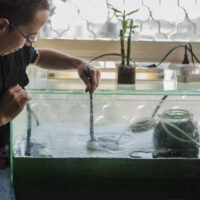Last updated on June 8th, 2023
Ash water, also known as Lye, is a powerful alkali base that can be created using rain water and natural wood ashes, often used for making homemade soap. By combining these two materials together, a powerful base called potassium hydroxide (KOH) is formed, which can be used for many industrial applications, particularly for its corrosive nature and high reactivity with acids.
In organic spirulina cultivation, Lye can be used to substitute some of the chemical nutrients being used with a more natural, organically-derived material. When used with proper care, Lye is a powerful tool to reduce your dependence on industrial fertilizers.
Collecting Your Ash and Water
As the name implies, you only need two ingredients to make ash water: wood ash and water.
The water source can be rainwater or spring water, preferably free of chemicals and excessive mineral levels, that are often found in city and well water.
Using wood ash from broad-leaved hardwood trees will result in better quality than if you use ash from soft woods or conifers. Whatever you do, always use ash that was burnt from natural tree branches and not processed wood.
Taking Precautions
Before discussing how to make ash water, it’s important to note that it can be a dangerous substance and extreme caution should be used when making or handling it – whether for commercial purposes or homemade.
Here are a few basic guidelines:
- Lye should never come in contact with aluminum as it will react with the metal.
- In certain cases, lye can cause chemical burns if it comes in contact with skin, and blindness if it gets in your eyes. In fact, when you get lye on your skin, it will begin reacting with the fatty acids on your skin.
- Always make and use lye in a well-ventilated area, and keep pets and children at a safe distance.
- Pants, a long sleeved shirt, rubber gloves, and eye protection should be worn when making or using lye.
- If you get lye on your skin, use vinegar to neutralize the solution. Immediately call 911 or the poison control center if an emergency arises while working with lye.
- Boil the ashes in a little soft water for about half an hour. Allow the ashes to settle to the bottom of the pan and then skim the liquid lye off the top.
Preparing the Lye
Lye can be prepared long in advance and be used for months afterwards. There are numerous ways to make it, here are a few of them:
- Mix ash with hot water and let it set before filtering out the ash.
- Drill holes in the bottom of a barrel, cover with straw, and then fill with ash. Pour rainwater over the ash and lye will be leached as the water filters thru the barrel. Collect the lye by placing a bucket or container underneath the barrel. This works, but the resulting solution is likely to be discolored by the straw. When lye reacts with lignin in the straw, the bonds are broken down and the fibers are left behind. After enough leachings, the remaining straw fibers will continue to work as an effective filter, but will no longer discolor the lye.
- Sieve 1kg of ash and place in a piece of cloth over a container, then pour 5L of warm water through them twice.
- If you’re only making a small portion of Culture Medium, you could cut the process short by simply adding raw ash to a bucket of water, wait for it to sink down and then gently scoop it with a cup to add into your culture medium. To be extra careful, make sure you sieve it well before adding, to prevent sedimentation of ash at the bottom of your tank.
Determining the strength of the Ash water
One of the difficulties when making ash water is determining the proper strength. One traditional method of determining strength is to see if a chicken feather will start to dissolve when placed in the ash water. A more accurate measure is to float an egg (still in the shell) in the lye solution. If the lye is of proper strength, the egg will float but only a quarter sized circle of the egg will be raised out of the water. If it floats any higher, the lye is too strong. If it doesn’t float high enough, the lye is too weak. Discard the egg after testing; it is not safe to eat.
Strengthening the concentration
Regardless of the method used, the more times you run the lye solution through a bed of ashes, the stronger it will become. Another way to raise the concentration of ash water is to boil it. The water will evaporate but the lye will not, so the solution will contain a higher percentage of lye.






